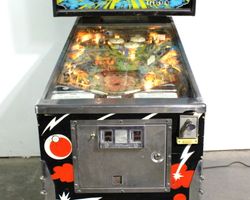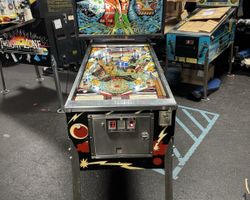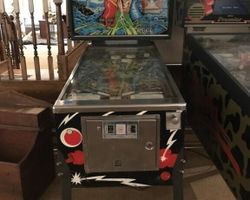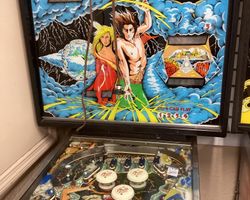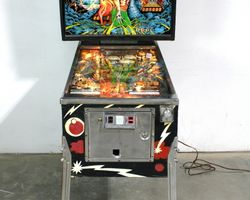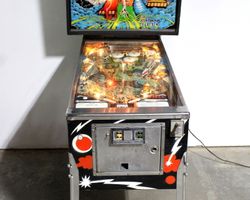Flash
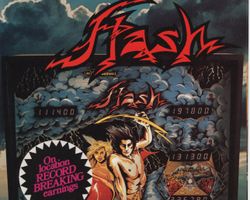
Average Prices: USD $200 to $1,200
Produced: October, 1978
Production Run: 19,505 units
Machine Type: Solid State Electronic
MPU: Williams System 4
Players: 4
Design by: Steve Ritchie
Art by: Constantino Mitchell
Mechanics by: John Jung
Sound by: Steve Ritchie, Randy Pfeiffer
"Flash" stands as a significant landmark in the history of pinball, a machine that not only captured the attention of players but also introduced innovations that reshaped the industry. Released by Williams Electronics, Incorporated, in February 1979, this solid-state electronic (SS) game quickly distinguished itself. The creative force behind its design was Steve Ritchie, a name that would become synonymous with fast, flowing pinball. He conceptualized the core layout, reportedly sketching it on a napkin during a flight, drawing inspiration from earlier designs like Bally's "Four Million B.C." The vibrant artwork, contributing to the machine's fantasy theme, was a collaboration between Constantino Mitchell and Jeanine Mitchell. Randy Pfeiffer was responsible for the groundbreaking sound design and software, while John Jung handled the mechanical engineering.
"Flash" represented a pivotal moment for Williams, serving as a testament to the capabilities of their System 4 MPU. Its production run of 19,505 units was unprecedented for the company at the time, significantly surpassing previous Williams titles. This commercial success underscored the machine's broad appeal and Williams' growing dominance in the market. A notable anecdote from designer Steve Ritchie highlights a desire to exceed 20,000 units, but Williams management opted to maintain market demand. Beyond its commercial impact, "Flash" is recognized for two key innovations: it was the first pinball machine from any manufacturer to feature dynamic background sound during gameplay, and the first to incorporate flash lamps, which would later become a staple across the industry.
Signature Features and Design
"Flash" presented players with a distinctly fresh experience, primarily through its two signature features: the flash lamps and the dynamic background sound. The flash lamps, strategically placed under the playfield, provided temporary, dazzling bursts of light. Unlike standard playfield lamps that merely indicate objectives or provide constant illumination, these flashers were designed purely for visual effect, creating a striking, almost cinematic, lightning-like spectacle that synchronized with impactful moments during play. This innovation elevated the visual excitement of the game, adding a layer of immersive spectacle previously unseen.
Equally transformative was the dynamic background sound. Before "Flash," pinball machines typically featured static, simple sounds, or effects that only triggered upon specific events. Randy Pfeiffer’s sound design for "Flash" introduced a continuously cycling, complex background soundscape that dramatically increased in pitch and speed as the player performed well. This innovative audio feedback served as an auditory gauge of a player's performance, creating an evolving sense of tension and excitement. It broadcasted success, drawing onlookers and fostering a more engaging, communal arcade experience. This dynamic audio element not only enhanced player immersion but also provided a continuous, compelling underscore to the fast-paced action on the playfield.
Playfield and Mechanics
The "Flash" playfield is a study in purposeful design, embodying Steve Ritchie's philosophy of fast-paced, high-flow gameplay. The layout is often described as a "Figure 8," a testament to its circular, connecting pathways that keep the ball in motion. At the heart of the lower playfield are three powerful flippers. The primary left and right flippers guard the outlanes and the central bank of targets, while a third flipper, positioned strategically on the upper right, facilitates unique shots.
The playfield is populated with eight drop targets, arranged in a challenging 5-bank and a 3-bank, demanding precision to clear for significant points and bonuses. Two standup targets offer additional scoring opportunities, while a central spinning target provides a high-scoring opportunity for repeated hits. Three robust pop bumpers are positioned in the upper playfield, maintaining ball agitation and creating chaotic scoring opportunities. Two slingshots flank the flippers, ensuring rapid rebound action. A kick-out hole adds an element of surprise and can lead to strategic ball returns.
The game's initial ball launch is distinctive: a manual plunger shoots the ball across the entire playfield to reach the top, establishing an immediate sense of scale and a unique skill shot opportunity. The overall aesthetic of the playfield is dominated by the "Flash" theme, featuring lightning bolts and a fantasy-inspired visual palette that, when combined with the flash lamps, creates a visually charged environment. The lighting, particularly the innovative flash lamps, is not merely functional but integral to the machine's immersive appeal, providing dramatic visual punctuation during gameplay.
Gameplay Dynamics
"Flash" gameplay is characterized by its directness and speed, appealing to players who value quick reflexes and precise shooting. The scoring system is straightforward yet engaging, with a maximum displayable score of 999,990 points per player, encouraging high-score chases. The primary objective revolves around systematically clearing the drop targets. Downing the 5-bank and 3-bank drop targets awards substantial points and can activate bonus multipliers, crucial for achieving high scores. The spinning target in the upper right quadrant offers a continuously accumulating score for each rotation, becoming a key focus for players aiming to maximize their points.
The skill shot at the game's start, where the plunger sends the ball across the playfield, challenges players to control the initial trajectory for bonus points or advantageous positioning. The third flipper on the upper right side of the playfield opens up unique shot angles, allowing players to direct the ball towards specific targets or to maintain flow through the upper playfield. Successful play involves a strategic balance of clearing drop targets, repeatedly hitting the spinner, and mastering the fast outlanes that demand quick saves. The dynamic background sound serves as a real-time indicator of a player's performance; as points accumulate and objectives are met, the sound's increasing tempo and pitch create a tangible sense of progression and excitement, making a successful run audibly thrilling.
Reception and Legacy
"Flash" has garnered a largely positive reception within the pinball community, cementing its status as a classic and a touchstone for solid-state era machines. Players frequently praise its fast-paced, energetic gameplay and the satisfying flow achieved through its carefully designed layout. The challenging shots, particularly those requiring precise use of the third flipper, are often highlighted as rewarding for skilled players. The innovative sound design, with its "wonderful thunder" and pioneering dynamic background audio, is consistently lauded as a groundbreaking element that added unprecedented excitement to the game. Many appreciate its historical significance as one of the first machines to integrate continuous background sound and flash lamps, features that are now standard in pinball design. The unique crossover plunger shot and fast inlanes are also noted as contributions to its distinct play experience.
However, "Flash" is not without its detractors. The most common criticism targets the artwork, which some describe as "ugly" or "not my taste," feeling it detracts from the machine's overall aesthetic appeal. Gameplay-wise, some find the outlanes unforgiving, leading to frustrating drains, and the center targets can be perceived as overly difficult to hit consistently. While the dynamic background sound was innovative, some players found its continuous nature or specific timbre to be annoying or ear-piercing over extended play sessions. A few minor points have been raised regarding perceived flimsiness of the playfield compared to other machines, or occasional issues with flippers and drop target reliability in older units.
Despite these criticisms, "Flash" holds a significant place in pinball history. It is recognized as a milestone game that profoundly influenced subsequent designs. Its emphasis on speed and flow set a precedent for a particular style of gameplay that many designers would emulate. The success of "Flash" helped Williams regain and solidify its position as a dominant force in pinball manufacturing, proving the commercial viability of innovative solid-state designs. Its introduction of flash lamps and dynamic background sound truly ushered in a new era of sensory engagement in pinball, shaping the player experience for decades to come. "Flash" remains readily available, a testament to its enduring popularity and significant production numbers, continuing to be enjoyed for its blend of classic challenge and groundbreaking features.
Sponsored Links
 Ebay Listings
Ebay Listings
 Auction Results
Auction Results
| Cost | Location | Date |
|---|---|---|
| USD $1,500 |  Michigan, United States Michigan, United States |
29 September, 2025 |
| USD $650 |  Maryland, United States Maryland, United States |
04 September, 2025 |
| USD $3,000 |  Florida, United States Florida, United States |
21 June, 2025 |
| USD $320 |  Pennsylvania, United States Pennsylvania, United States |
11 June, 2025 |
| USD $1,050 |  Wisconsin, United States Wisconsin, United States |
23 March, 2025 |
| USD $1,450 |  New York, United States New York, United States |
21 February, 2025 |
| EUR €800 |  Hessen, Germany Hessen, Germany |
17 December, 2024 |
| USD $700 |  Washington, United States Washington, United States |
06 December, 2024 |
| EUR €2,200 |  Hessen, Germany Hessen, Germany |
03 December, 2024 |
| USD $1,500 |  Illinois, United States Illinois, United States |
15 November, 2024 |


Private Policy · Search Website · Contact Us
As an eBay Partner, we may earn a commission from qualifying purchases made through links on this site, at no additional cost to you.
All trademarks and copyrighted materials remain property of their respective owners. All other content copyright 2007 - 2025 Pinpedia.

